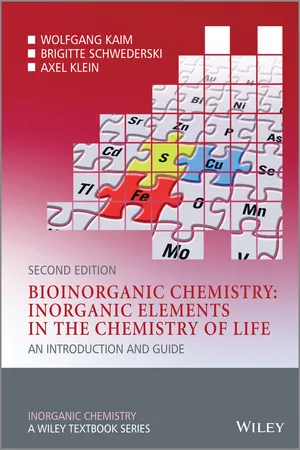
Bioinorganic Chemistry -- Inorganic Elements in the Chemistry of Life
An Introduction and Guide
- English
- ePUB (mobile friendly)
- Available on iOS & Android
Bioinorganic Chemistry -- Inorganic Elements in the Chemistry of Life
An Introduction and Guide
About this book
The field of Bioinorganic Chemistry has grown significantly in recent years; now one of the major sub-disciplines of Inorganic Chemistry, it has also pervaded other areas of the life sciences due to its highly interdisciplinary nature.
Bioinorganic Chemistry: Inorganic Elements in the Chemistry of Life, Second Edition provides a detailed introduction to the role of inorganic elements in biology, taking a systematic element-by-element approach to the topic. The second edition of this classic text has been fully revised and updated to include new structure information, emerging developments in the field, and an increased focus on medical applications of inorganic compounds. New topics have been added including materials aspects of bioinorganic chemistry, elemental cycles, bioorganometallic chemistry, medical imaging and therapeutic advances.
Topics covered include:
- Metals at the center of photosynthesis
- Uptake, transport, and storage of essential elements
- Catalysis through hemoproteins
- Biological functions of molybdenum, tungsten, vanadium and chromium
- Function and transport of alkaline and alkaline earth metal cations
- Biomineralization
- Biological functions of the non-metallic inorganic elements
- Bioinorganic chemistry of toxic metals
- Biochemical behavior of radionuclides and medical imaging using inorganic compounds
- Chemotherapy involving non-essential elements
Frequently asked questions
- Essential is ideal for learners and professionals who enjoy exploring a wide range of subjects. Access the Essential Library with 800,000+ trusted titles and best-sellers across business, personal growth, and the humanities. Includes unlimited reading time and Standard Read Aloud voice.
- Complete: Perfect for advanced learners and researchers needing full, unrestricted access. Unlock 1.4M+ books across hundreds of subjects, including academic and specialized titles. The Complete Plan also includes advanced features like Premium Read Aloud and Research Assistant.
Please note we cannot support devices running on iOS 13 and Android 7 or earlier. Learn more about using the app.
Information
- metalloenzymes (ca. 40% of the known enzymes, especially oxidoreductases (Fe, Cu, Mn, Mo, Ni, V) and hydrolases (e.g. peptidases, phosphatases: Zn, Mg; Ca, Fe);
- nonenzymatic metalloproteins (e.g. hemoglobin: Fe);
- low-molecular-weight natural products (e.g. chlorophyll: Mg);
- coenzymes, vitamins (e.g. vitamin B12: Co);
- nucleic acids: (e.g. DNAn−(M+)n, M = Na, K);
- hormones (e.g. thyroxine, triiodothyronine: I);
- antibiotics (e.g. ionophores: valinomycin/K);
- biominerals (e.g. bones, teeth, shells, coral, pearls: Ca, Si,…).
- physics (→ techniques for detection and characterization);
- various areas of biology (→ supply of material and specific modifications based on site-directed mutagenesis);
- agricultural and nutritional sciences (→ effects of inorganic elements and their mutual interdependence);
- pharmacology (→ interaction between drugs and endogeneous or exogeneous inorganic substances);
- medicine (→ imaging and other diagnostic aids, chemotherapy);
- toxicology and the environmental scien...
Table of contents
- Cover
- Series
- Title Page
- Copyright
- Preface to the Second Edition
- Preface to the First Edition
- Chapter 1: Historical Background, Current Relevance and Perspectives
- Chapter 2: Some General Principles
- Chapter 3: Cobalamins, Including Vitamin and Coenzyme B12
- Chapter 4: Metals at the Center of Photosynthesis: Magnesium and Manganese
- Chapter 5: The Dioxygen Molecule, O2: Uptake, Transport and Storage of an Inorganic Natural Product
- Chapter 6: Catalysis through Hemoproteins: Electron Transfer, Oxygen Activation and Metabolism of Inorganic Intermediates
- Chapter 7: Iron–Sulfur and Other Non-heme Iron Proteins
- Chapter 8: Uptake, Transport and Storage of an Essential Element, as Exemplified by Iron
- Chapter 9: Nickel-containing Enzymes: The Remarkable Career of a Long-overlooked Biometal
- Chapter 10: Copper-containing Proteins: An Alternative to Biological Iron
- Chapter 11: Biological Functions of the “Early” Transition Metals: Molybdenum, Tungsten, Vanadium and Chromium
- Chapter 12: Zinc: Structural and Gene-regulatory Functions and the Enzymatic Catalysis of Hydrolysis and Condensation Reactions
- Chapter 13: Unequally Distributed Electrolytes: Function and Transport of Alkali and Alkaline Earth Metal Cations
- Chapter 14: Catalysis and Regulation of Bioenergetic Processes by the Alkaline Earth Metal Ions Mg2+ and Ca2+
- Chapter 15: Biomineralization: The Controlled Assembly of “Advanced Materials” in Biology
- Chapter 16: Biological Functions of the Nonmetallic Inorganic Elements
- Chapter 17: The Bioinorganic Chemistry of the Quintessentially Toxic Metals
- Chapter 18: Biochemical Behavior of Radionuclides and Medical Imaging Using Inorganic Compounds
- Chapter 19: Chemotherapy Involving Nonessential Elements
- Index